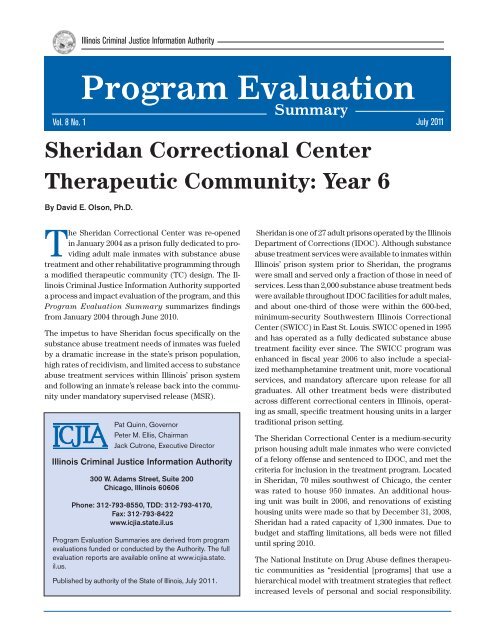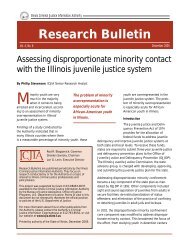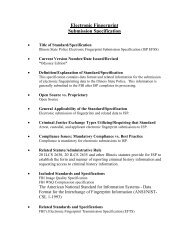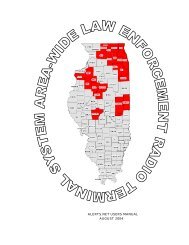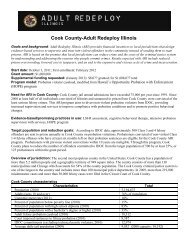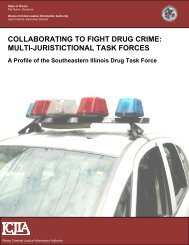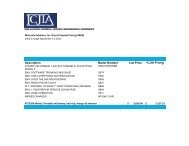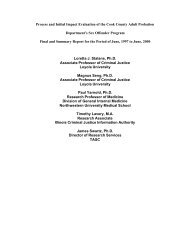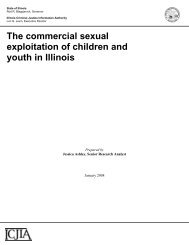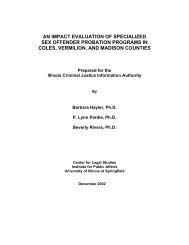Sheridan Correctional Center Therapeutic Community
Sheridan Correctional Center Therapeutic Community
Sheridan Correctional Center Therapeutic Community
Create successful ePaper yourself
Turn your PDF publications into a flip-book with our unique Google optimized e-Paper software.
Illinois Criminal Justice Information Authority<br />
Program Evaluation<br />
Summary<br />
Vol. 8 No. 1 July 2011<br />
<strong>Sheridan</strong> <strong>Correctional</strong> <strong>Center</strong><br />
<strong>Therapeutic</strong> <strong>Community</strong>: Year 6<br />
By David E. Olson, Ph.D.<br />
The <strong>Sheridan</strong> <strong>Correctional</strong> <strong>Center</strong> was re-opened<br />
in January 2004 as a prison fully dedicated to providing<br />
adult male inmates with substance abuse<br />
treatment and other rehabilitative programming through<br />
a modified therapeutic community (TC) design. The Illinois<br />
Criminal Justice Information Authority supported<br />
a process and impact evaluation of the program, and this<br />
Program Evaluation Summary summarizes findings<br />
from January 2004 through June 2010.<br />
The impetus to have <strong>Sheridan</strong> focus specifically on the<br />
substance abuse treatment needs of inmates was fueled<br />
by a dramatic increase in the state’s prison population,<br />
high rates of recidivism, and limited access to substance<br />
abuse treatment services within Illinois’ prison system<br />
and following an inmate’s release back into the community<br />
under mandatory supervised release (MSR).<br />
Pat Quinn, Governor<br />
Peter M. Ellis, Chairman<br />
Jack Cutrone, Executive Director<br />
Illinois Criminal Justice Information Authority<br />
300 W. Adams Street, Suite 200<br />
Chicago, Illinois 60606<br />
Phone: 312-793-8550, TDD: 312-793-4170,<br />
Fax: 312-793-8422<br />
www.icjia.state.il.us<br />
Program Evaluation Summaries are derived from program<br />
evaluations funded or conducted by the Authority. The full<br />
evaluation reports are available online at www.icjia.state.<br />
il.us.<br />
Published by authority of the State of Illinois, July 2011.<br />
<strong>Sheridan</strong> is one of 27 adult prisons operated by the Illinois<br />
Department of Corrections (IDOC). Although substance<br />
abuse treatment services were available to inmates within<br />
Illinois’ prison system prior to <strong>Sheridan</strong>, the programs<br />
were small and served only a fraction of those in need of<br />
services. Less than 2,000 substance abuse treatment beds<br />
were available throughout IDOC facilities for adult males,<br />
and about one-third of those were within the 600-bed,<br />
minimum-security Southwestern Illinois <strong>Correctional</strong><br />
<strong>Center</strong> (SWICC) in East St. Louis. SWICC opened in 1995<br />
and has operated as a fully dedicated substance abuse<br />
treatment facility ever since. The SWICC program was<br />
enhanced in fiscal year 2006 to also include a specialized<br />
methamphetamine treatment unit, more vocational<br />
services, and mandatory aftercare upon release for all<br />
graduates. All other treatment beds were distributed<br />
across different correctional centers in Illinois, operating<br />
as small, specific treatment housing units in a larger<br />
traditional prison setting.<br />
The <strong>Sheridan</strong> <strong>Correctional</strong> <strong>Center</strong> is a medium-security<br />
prison housing adult male inmates who were convicted<br />
of a felony offense and sentenced to IDOC, and met the<br />
criteria for inclusion in the treatment program. Located<br />
in <strong>Sheridan</strong>, 70 miles southwest of Chicago, the center<br />
was rated to house 950 inmates. An additional housing<br />
unit was built in 2006, and renovations of existing<br />
housing units were made so that by December 31, 2008,<br />
<strong>Sheridan</strong> had a rated capacity of 1,300 inmates. Due to<br />
budget and staffing limitations, all beds were not filled<br />
until spring 2010.<br />
The National Institute on Drug Abuse defines therapeutic<br />
communities as “residential [programs] that use a<br />
hierarchical model with treatment strategies that reflect<br />
increased levels of personal and social responsibility.
Illinois Criminal Justice Information Authority<br />
Table 1<br />
<strong>Sheridan</strong> admissions, exits, and existing population from January 2004 to June 2010<br />
Number<br />
Percentage of<br />
total admissions*<br />
Total admissions 6,680 100%<br />
Number incarcerated<br />
on 6/30/2010 949 14.2%<br />
Percentage<br />
of total exits*<br />
Exits** 5,731 85.8% 100%<br />
Median length<br />
of stay<br />
Successful exits*** 4,328 75.6% 382 days<br />
Disciplinary removals 1,069 18.7% 138 days<br />
Non-disciplinary removals 325 5.7% 50 days<br />
*Percentages may not equal 100% due to rounding.<br />
**Five inmates who died at <strong>Sheridan</strong> and four inmates with other extraordinary circumstances resulting in their release were<br />
included in the total exits but not within the specific sub-categories.<br />
*** Includes 4,162 discharged to mandatory supervised release and 166 released to an IDOC Adult Transition <strong>Center</strong>.<br />
Peer influence, mediated through a variety of group processes,<br />
is used to help individuals learn and assimilate<br />
social norms and develop more effective social skills.” At<br />
<strong>Sheridan</strong>, this is accomplished through the provision of<br />
individual and group treatment delivered by a contractual<br />
service provider. During the earlier years of operation,<br />
services were provided by the Gateway Foundation.<br />
Since October 2006, WestCare has been the treatment<br />
provider.<br />
<strong>Sheridan</strong> inmates receive a variety of other services,<br />
including educational programming, job and vocational<br />
training, and anger management and parenting skills<br />
classes. Upon release from <strong>Sheridan</strong>, all participants<br />
are required to participate in substance abuse aftercare<br />
services, usually outpatient treatment, and also receive<br />
clinical case management services from Treatment Accountability<br />
for Safe Communities (TASC), job referral<br />
and placement services through the Safer Foundation,<br />
along with supervision by IDOC parole agents under<br />
MSR.<br />
<strong>Sheridan</strong> eligibility<br />
Unlike other prison-based TCs in the United States, which<br />
often limit eligibility to only those convicted of drug law<br />
violations or driving under the influence, or only serve<br />
probation or parole violators, the criteria for inmates to<br />
participate in <strong>Sheridan</strong> is quite inclusive. Indeed, during<br />
the planning phase of <strong>Sheridan</strong> in 2003, initial “pipeline”<br />
studies performed by Authority researchers and IDOC<br />
determined that to keep <strong>Sheridan</strong> operating at a level that<br />
would maximize access to the services (around 950 inmates),<br />
the eligibility criteria could not be too restrictive.<br />
After a number of different iterations of potential target<br />
populations, the following final criteria were adopted:<br />
1) Participants must be identified as in need of treatment<br />
based on a brief drug use and treatment need screen<br />
(Texas Christian University Drug Screen II), administered<br />
at an IDOC Reception and Classification <strong>Center</strong>, and a<br />
subsequent comprehensive drug assessment (the Addiction<br />
Severity Index, or ASI) performed at <strong>Sheridan</strong>.<br />
2) Participants must be projected to serve nine to 36<br />
months. Originally, the requirement was that inmates be<br />
projected to serve between six and 24 months in prison,<br />
based on the general research literature regarding treatment<br />
effectiveness and treatment dose. This was changed<br />
in the fall 2006 to nine to 24 months, and again in 2010<br />
to nine to 36 months, as a result of evaluation findings<br />
that indicated inmates who spent less than nine months<br />
at <strong>Sheridan</strong> showed recidivism rates that were not much<br />
lower than those of inmates who did not receive treatment.<br />
Because the length of stay for parole violators or<br />
inmates with outstanding warrants/detainers cannot be<br />
accurately predicted, they are excluded from participating<br />
in the <strong>Sheridan</strong> program.<br />
3) Inmates serving a sentence for murder or a sex offense,<br />
or have a murder or sex offense conviction in their<br />
criminal background, are ineligible.<br />
4) Participants must be eligible for placement in a medium<br />
security facility and free of mental health issues<br />
that cannot be managed at <strong>Sheridan</strong>.<br />
5) Participants must volunteer for the program.<br />
6) Inmates who previously participated in the <strong>Sheridan</strong><br />
program are ineligible.<br />
<br />
Program Evaluation Summary
Illinois Criminal Justice Information Authority<br />
Characteristic<br />
Average age<br />
Race<br />
Marital status<br />
Children<br />
Education level<br />
<strong>Sheridan</strong><br />
admissions<br />
31.8 years<br />
Black 66.4%<br />
White 24.4%<br />
Hispanic 8.9%<br />
Married 15.6%<br />
Single 84.4%<br />
None 32.9%<br />
One or more 67.1%<br />
No high school diploma or GED 56.5%<br />
At least a high school diploma or GED 43.5%<br />
Gang affiliation<br />
Table 2<br />
Participant characteristics,<br />
January 2004 to June 2010*<br />
Prior prison sentence<br />
Yes 60%<br />
No 40%<br />
None 35.7%<br />
One 24.5%<br />
Two or more 39.8%<br />
Average total prior arrests 20.5<br />
Average prior arrests for drug<br />
law violations 5.1<br />
Primary substance of abuse<br />
Age at first drug or alcohol use<br />
Prior treatment admissions<br />
Alcohol 27%<br />
Marijuana 29%<br />
Cocaine 17%<br />
Heroin/opiates 22%<br />
Other 5%<br />
Under 15 59.1%<br />
15-16 21.3%<br />
17 or older 19.6%<br />
No prior treatment 47.4%<br />
One or two prior admissions 35.9%<br />
More than two prior admissions 17.7%<br />
*Percentages may not equal 100% due to rounding.<br />
Participant characteristics<br />
During the first six-and-a-half years of operation (January<br />
2004 through June 2010), 6,680 inmates were admitted to<br />
the <strong>Sheridan</strong> <strong>Correctional</strong> <strong>Center</strong> program. On June 30,<br />
2010, 949 inmates were residing at <strong>Sheridan</strong> (Table 1). Of<br />
outgoing <strong>Sheridan</strong> participants, 4,328 had completed the<br />
prison component of the program and were released to<br />
MSR or an adult transition center. Another 1,069 inmates<br />
were removed from <strong>Sheridan</strong> for disciplinary reasons<br />
and sent to another facility. About one-third of them had<br />
refused to participate in treatment programming, while<br />
the other two-thirds were transferred for violating other<br />
IDOC rules.<br />
Only 325 inmates were removed from <strong>Sheridan</strong> for nondisciplinary<br />
reasons (less than 6 percent over the six-year<br />
period), including identification of mental health issues<br />
that interfered with ability to participate in the program,<br />
outstanding warrants or detainers that were either going<br />
to require the inmate to appear in court frequently or<br />
face deportation following completion of a sentence, too<br />
much or too little time to serve to meet program eligibility<br />
requirements, inmates who were later determined to have<br />
a criminal history that prohibited their participation in<br />
<strong>Sheridan</strong>, and serious medical conditions or safety concerns<br />
related to being housed with specific inmates.<br />
Half of the non-disciplinary removals occurred within<br />
50 days of admission to <strong>Sheridan</strong>. Closer inspection of<br />
these data revealed that time periods between admission<br />
and transfer for non-disciplinary removals substantially<br />
decreased over time due to improved screening and<br />
identification of inmates who were not appropriate for<br />
<strong>Sheridan</strong> as the program has evolved.<br />
During the period studied, most of those admitted to<br />
<strong>Sheridan</strong> were black, with an average age of 32 years<br />
old (Table 2), and were primarily sentenced to prison<br />
from Cook County (Chicago) and other urban areas of<br />
the state for drug and property crimes. Cook County not<br />
only accounted for the largest number of admissions to<br />
prison in Illinois, but accounted for more than one-half<br />
(52.3 percent) of the 6,680 admitted to <strong>Sheridan</strong>. The<br />
next largest group of inmates admitted to <strong>Sheridan</strong> were<br />
sentenced out of Winnebago County (Rockford), followed<br />
by the suburban counties bordering Cook—DuPage, Will,<br />
Lake, and Kane counties. Individuals from Cook, DuPage,<br />
Kane, Lake, Will, and Winnebago counties accounted<br />
for 71 percent of <strong>Sheridan</strong> admissions. The remaining<br />
29 percent of <strong>Sheridan</strong> admissions came from 73 other<br />
counties, primarily in northern Illinois. A higher proportion<br />
of inmates admitted to <strong>Sheridan</strong> from Cook County<br />
Program Evaluation Summary
Illinois Criminal Justice Information Authority<br />
(primarily Chicago) were black (81 percent) than those<br />
from the rest of the committing counties combined, as<br />
50 percent of those admitted to <strong>Sheridan</strong> from outside of<br />
Cook County were black.<br />
Although most <strong>Sheridan</strong> participants were single and had<br />
never been married (84 percent), 67 percent had children.<br />
Upon admission to <strong>Sheridan</strong>, 43 percent were high-school<br />
graduates or had received a GED. Most <strong>Sheridan</strong> inmates<br />
were unemployed prior to incarceration, and only 27<br />
percent were employed full-time prior to incarceration.<br />
Even more illustrative of the limited formal employment<br />
experiences among those admitted to <strong>Sheridan</strong> is the fact<br />
that 63 percent had never previously held a job for more<br />
than two years.<br />
Clear evidence of an extensive prior history of involvement<br />
in criminal behavior and the justice system also existed<br />
among <strong>Sheridan</strong> participants. <strong>Sheridan</strong> admissions<br />
had, on average, almost 21 prior arrests with charges<br />
for drug law violations, property crimes, and crimes of<br />
violence, such as robbery, battery, and assault, and 94<br />
percent had five or more prior arrests. Of those admitted<br />
to <strong>Sheridan</strong> during the period examined, 66 percent had<br />
served previous prison sentences in IDOC.<br />
Participant substance abuse histories were quite lengthy<br />
and varied, but prior exposure to substance abuse treatment<br />
was limited. Upon admission to <strong>Sheridan</strong>, 47 percent<br />
of the participants had never before participated in substance<br />
abuse treatment. Primary substances of abuse also<br />
varied, with 29 percent reporting marijuana, 27 percent<br />
reporting alcohol, 22 percent reporting heroin/opiates,<br />
and 17 percent reporting cocaine as their primary substance<br />
of abuse. Further, 50 percent indicated that they<br />
abused multiple substances, and 11 percent reported<br />
previous intravenous drug use.<br />
Despite the growing concern regarding methamphetamine<br />
production and use in Illinois, particularly in rural<br />
communities, <strong>Sheridan</strong> has not seen a large number of<br />
admissions where this drug was cited by the participants<br />
as their primary substance of abuse. Less than 2 percent<br />
of those admitted to <strong>Sheridan</strong> reported amphetamine or<br />
methamphetamine as their primary substance of abuse.<br />
Part of this could be influenced by the fact that the majority<br />
of admissions to <strong>Sheridan</strong> were from northern Illinois<br />
where methamphetamine has not had a large impact,<br />
unlike the more rural jurisdictions in central and southern<br />
Illinois (Bauer, 2006). Further, since October 2006,<br />
Illinois’ Southwestern <strong>Correctional</strong> <strong>Center</strong> has operated<br />
a specialized methamphetamine treatment unit where<br />
many of those identified as in need of methamphetamine<br />
treatment are sent.<br />
Beyond the extensive prior substance abuse history, 55<br />
percent of <strong>Sheridan</strong> participants had also been previously<br />
hospitalized for medical problems (excluding drug<br />
overdoses), and 33 percent of <strong>Sheridan</strong> participants had<br />
been hospitalized multiple times. The average number<br />
of prior hospitalizations (excluding drug overdoses or<br />
drug detoxification) among all <strong>Sheridan</strong> admissions was<br />
two. A sign of the exposure to violence experienced by<br />
<strong>Sheridan</strong> participants is the fact that 8 percent had been<br />
previously hospitalized as a result of gun-shot wounds. In<br />
addition, 27 percent of those admitted to <strong>Sheridan</strong> were<br />
also identified as having a chronic medical condition,<br />
and 19 percent were taking prescription medications for<br />
medical conditions.<br />
Although many prison-based TCs in the United States<br />
target only those convicted of specific drug law violations,<br />
most often drug possession, <strong>Sheridan</strong> program planners<br />
recognized that only considering an inmate’s conviction<br />
offense would exclude a substantial number of people<br />
in need of treatment. <strong>Sheridan</strong> houses inmates serving<br />
time for convictions ranging from felony-level DUI, and<br />
drug sale and possession, to burglary, robbery, and battery.<br />
In aggregate, the largest single offense category for<br />
admissions to <strong>Sheridan</strong> was for drug law violations (42<br />
percent), followed by property crimes (32) and violent<br />
offenses (24 percent) (Table 3).<br />
Of all <strong>Sheridan</strong> admissions, only 6.5 percent were the<br />
result of a Class X felony conviction, primarily for armed<br />
robbery and drug sale/delivery offenses involving 15<br />
grams or more of cocaine or heroin. Those sentenced to<br />
prison for a Class X felony—the most serious felony class<br />
other than murder—are required under Illinois law to be<br />
on MSR upon release from prison for three years. Illinois<br />
law specifies that those released from prison after serving<br />
a sentence for a Class 1 or 2 felony must be supervised<br />
on MSR for two years, and 72 percent of those admitted<br />
to <strong>Sheridan</strong> fell into these two felony classes. Finally, 22<br />
percent of <strong>Sheridan</strong> admissions were convicted of Class<br />
3 and 4 felonies, and those inmates were required to<br />
undergo one year of MSR post-release.<br />
More than half of those admitted to <strong>Sheridan</strong> were eligible<br />
for Earned Good Conduct Credit (EGCC), which cuts<br />
time off of a prison sentence by participating in substance<br />
abuse treatment programs (in addition to traditional<br />
day-for-day good conduct credits and Meritorious Good<br />
Conduct credit for which almost all inmates at <strong>Sheridan</strong><br />
are eligible). Inmates receiving EGCC for <strong>Sheridan</strong> par-<br />
<br />
Program Evaluation Summary
Illinois Criminal Justice Information Authority<br />
Table 3<br />
Most prevalent holding offenses of <strong>Sheridan</strong> participants, January 2004 to June 2010*<br />
Number<br />
Percentage<br />
of total**<br />
Percentage<br />
within category**<br />
Drug law violation 2,826 42.3% 100%<br />
Sale/delivery of a controlled substance 1,617 24.2% 57.2%<br />
Possession of a controlled substance 813 12.2% 28.8%<br />
DUI 253 3.8% 9%<br />
Sale/delivery/production<br />
of cannabis 121 1.8% 4.3%<br />
Other 22 0.3% 0.8%<br />
Property crimes 2,174 32.5% 100%<br />
Burglary 1,216 18.2% 55.9%<br />
Theft 461 6.9% 21.2%<br />
Motor vehicle theft 316 4.7% 14.5%<br />
Forgery/deception/fraud 144 2.2% 6.6%<br />
Other 37 0.6% 1.7%<br />
Violent crimes 1,620 24.3% 100%<br />
Firearm possession by<br />
convicted felon/<br />
other weapon offenses 446 6.7% 27.5%<br />
Assault battery 405 6.1% 25%<br />
Robbery 379 5.7% 23.4%<br />
Armed robbery 283 4.2% 17.5%<br />
Other 107 1.6% 6.6%<br />
Other 60 0.9% 100%<br />
Total 6,680 100%<br />
*In cases where inmates were convicted and sentenced for multiple offenses, the most serious offense, or that<br />
which carries the longest sentence, is counted as their “holding” offense or current sentence offense.<br />
**Percentages may not equal 100% due to rounding.<br />
ticipation had higher rates of successful completion than<br />
those who were ineligible for this time credit. In addition,<br />
EGCC reduced the length of incarceration, thereby more<br />
quickly freeing up bed space at the facility.<br />
More than 259,872 days of EGCC were earned by those<br />
who graduated from the program during the first six<br />
state fiscal years of operation (FY05 through FY10).<br />
This EGCC time is equivalent to 119 years of reduced<br />
incarceration per year. Given the average annual cost of<br />
$23,394 to house an IDOC inmate, the reduced incarceration<br />
resulting from EGCC for substance abuse treatment<br />
programming is valued at $2.78 million annually, or $16.7<br />
million during the first six state fiscal years of operation.<br />
An additional 119 participants are able to enroll in the<br />
<strong>Sheridan</strong> program each year due to the bed space made<br />
available through EGCC.<br />
<strong>Sheridan</strong> progression<br />
In addition to various assessments and the development<br />
of a comprehensive, multidisciplinary treatment plan,<br />
<strong>Sheridan</strong> participants undergo an orientation phase during<br />
their first month at the facility. During orientation,<br />
inmates are provided with basic drug education, an overview<br />
of the TC philosophy and program rules, and other<br />
motivational activities and exercises to get them prepared<br />
for their treatment and participation in the program. During<br />
this phase, inmates will also begin to get involved in<br />
educational and vocational programming and take on<br />
various responsibilities around the institution.<br />
Following successful orientation phase completion (Phase<br />
1), which requires inmates to pass an exam showing that<br />
they understand the TC philosophy and basic issues regarding<br />
their drug abuse, inmates are placed into smaller<br />
housing units and “families,” where they begin their regi-<br />
Program Evaluation Summary
Illinois Criminal Justice Information Authority<br />
Figure 1<br />
Participant psychological functioning scale changes from Phase 1 to Phase 3 (N=1,334)<br />
50 Phase 1<br />
Phase 3<br />
40<br />
Scoring (scale from 10-50)<br />
30<br />
20<br />
10<br />
0<br />
Self-esteem<br />
Depression<br />
Anxiety<br />
Decision-making<br />
Expectancy (N=723)*<br />
Psychological function<br />
*Likelihood of refraining from drug use. Client scoring in this category was initiated in May 2008.<br />
men of intensive, daily substance abuse treatment (Phase<br />
2). Each inmate at <strong>Sheridan</strong> is required to participate in<br />
group treatment five days per week for a minimum of<br />
15 hours per week. This programming includes didactic<br />
groups, process groups, encounter groups, cognitive<br />
restructuring program groups, aggression management<br />
and domestic violence groups, behavior management,<br />
TC structures and responsibilities, and support groups<br />
(Illinois Department of Corrections 2006).<br />
Inmates are identified as being in either AM or PM<br />
groups, meaning that half of the inmates at <strong>Sheridan</strong> are<br />
participating in intensive drug treatment in the morning,<br />
while the other half is involved in various educational,<br />
vocational, or job assignments. After a lunch hour, the<br />
groups then shift. The beginning and end of each day<br />
involves group meetings, and inmates are also provided<br />
with time in the evening to participate in recreational<br />
programming and complete assignments related to their<br />
treatment programming. The schedule remains the same<br />
Monday through Friday. Visitation with friends and family<br />
members is only allowed on the weekends.<br />
Once an inmate has completed Phases 2 and 3 (additional<br />
intensive treatment within the facility), they enter Phase<br />
4, which focuses primarily on the development of job and<br />
vocational skills, but still involves daily participation in<br />
the therapeutic community and frequent group treatment<br />
programming. To enter Phase 4, participants are required<br />
to complete a minimum of 12 months at the <strong>Sheridan</strong><br />
<strong>Correctional</strong> <strong>Center</strong>, demonstrate leadership within their<br />
treatment group and the facility, and be active participants<br />
of the therapeutic community.<br />
Changes in social and psychological<br />
functioning and criminal thinking patterns<br />
The primary goal of the <strong>Sheridan</strong> <strong>Correctional</strong> <strong>Center</strong> TC<br />
is to reduce offender substance abuse and involvement<br />
in criminal activity through the provision of treatment<br />
that improves the psychological and social functioning of<br />
participants, reduces their criminal thinking patterns, and<br />
provides them with educational and vocational programming<br />
and experiences that will improve their chances of<br />
success upon release from prison.<br />
To gauge the degree to which <strong>Sheridan</strong> participants have<br />
changed their ways of thinking about their criminal activity,<br />
and how their psychological and social functioning<br />
changed during the course of program participation,<br />
participants complete a series of self-administered assessments<br />
at each program phase change. These surveys,<br />
<br />
Program Evaluation Summary
Illinois Criminal Justice Information Authority<br />
Figure 2<br />
Client evaluation of treatment at Phase 2*<br />
60%<br />
Score 10-19<br />
Score 20-29<br />
Score 30-39<br />
Score 40-50<br />
50%<br />
40%<br />
30%<br />
20%<br />
10%<br />
0<br />
Treatment participation<br />
Treatment satisfaction<br />
Counseling report<br />
Peer support<br />
*Scores ranged from 10 to 50.<br />
developed by the Texas Christian University Institute for<br />
Behavioral Research, are used extensively in treatment<br />
programs serving criminal populations for program<br />
evaluation purposes and to monitor client progress and<br />
needs.<br />
The psychological functioning assessment gauged five different<br />
dimensions of psychological functioning, including:<br />
self-esteem, depression, anxiety, decision making, and<br />
expectancy (likelihood of refraining from drug use). The<br />
scales produced through these assessments resulted in<br />
scores ranging from 10 to 50 (Figure 1). The social functioning<br />
assessment completed by participants provided<br />
quantitative assessments of three dimensions of social<br />
functioning: hostility, risk taking, and social support.<br />
Six dimensions of criminal thinking, including entitlement<br />
(sense of ownership and privilege, misidentifying<br />
wants as needs), justification, power orientation (need<br />
for power, control and retribution), cold-heartedness,<br />
criminal rationalization, and personal irresponsibility<br />
were also measured at phase changes.<br />
The assessments revealed that as participants matriculated<br />
through the <strong>Sheridan</strong> program phases, levels of<br />
psychological and social functioning improved, criminal<br />
thinking patterns decreased, and participants had very<br />
positive views of their treatment and high levels of rapport<br />
and support from their counselors and peers. Improvements<br />
were seen across all measures of psychological<br />
and social functioning, and criminal thinking patterns as<br />
participants matriculated from Phase 1 (orientation) to<br />
Phase 3 (completion of intensive treatment within the<br />
facility). The surveys also indicated levels of hostility and<br />
risk-taking were reduced, and the level of social support<br />
increased. For example, the scale measuring depression<br />
decreased from an average of 25 at the beginning of Phase<br />
1 to 20 at the beginning of Phase 3.<br />
Another set of questions gauged the Treatment Engagement<br />
Process by asking participants to indicate how<br />
strongly they agree or disagree with 36 statements in an<br />
effort to construct measures of treatment participation,<br />
treatment satisfaction, counseling rapport, and peer support<br />
(Figure 2).<br />
The majority of participants who completed Phase 2 had<br />
positive views of their treatment participation, treatment<br />
satisfaction, counselor rapport, and peer support. Almost<br />
half had a score of 30 to 39 on the treatment satisfaction<br />
scale, and an additional 36 percent had a score of 40 to<br />
50. The mean score on the treatment satisfaction scale at<br />
the completion of Phase 2 was 36, indicating satisfaction<br />
with treatment. Also, 85 percent of Phase 2 completers<br />
Program Evaluation Summary
Illinois Criminal Justice Information Authority<br />
Figure 3<br />
Rates of treatment completion/still enrolled among all releasees<br />
and releasees entering aftercare<br />
100%<br />
Percent completing/still enrolled in treatment<br />
90%<br />
80%<br />
70%<br />
60%<br />
50%<br />
40%<br />
30%<br />
20%<br />
10%<br />
0<br />
2005<br />
2006<br />
2007<br />
2008<br />
2009<br />
2010<br />
Fiscal year of release<br />
Completion among only <strong>Sheridan</strong><br />
participants entering post-release<br />
aftercare<br />
Completion among<br />
all <strong>Sheridan</strong> releasees<br />
scored counselor rapport at 30 or higher, with a mean<br />
score on this scale of 36.<br />
Program completion and release<br />
to the community<br />
The length of time an inmate spends at <strong>Sheridan</strong> is determined<br />
exclusively by the length of the prison sentence<br />
imposed by the court, minus jail, good conduct, and any<br />
other statutorily allowable credit. As such, an inmate<br />
can successfully complete the institutional phase of<br />
<strong>Sheridan</strong> without completing their treatment’s clinical<br />
components. However, because every inmate released<br />
from <strong>Sheridan</strong> is required to be on MSR for a statutorily<br />
determined length of time, those released from <strong>Sheridan</strong><br />
are required to participate in aftercare, or continue their<br />
treatment in the community if it is deemed necessary by<br />
administrators.<br />
Prior research has consistently found that aftercare enhances<br />
positive outcomes of prison-based and other intensive<br />
residential substance abuse treatment programs,<br />
including additional outpatient treatment, participation<br />
in support groups, and relapse prevention programs. All<br />
inmates released from <strong>Sheridan</strong> are required as a condition<br />
of MSR to participate in some type of treatment, the<br />
nature of which is determined by the multidisciplinary<br />
team that meets prior to the release of each inmate.<br />
Inmates are referred by TASC to a program that is accessible<br />
and appropriate for their particular needs. Intake<br />
assessments for these community-based referrals are<br />
scheduled prior to the inmate’s release, and usually take<br />
place within two weeks post-release.<br />
During the first six-and-a-half years of operation, data<br />
from IDOC indicate that 4,328 inmates successfully completed<br />
the institutional phase of <strong>Sheridan</strong> and were given<br />
either MSR or sent to an adult transition center in the<br />
community. TASC does not provide post-release clinical<br />
case management to individuals discharged to a transition<br />
center. This left 4,162 <strong>Sheridan</strong> releasees eligible for<br />
post-release services through June 30, 2010.<br />
During the period examined, 4,098 eligible releasees had<br />
at least one referral to some type of aftercare service.<br />
Intensive outpatient treatment accounted for the single<br />
largest category of referrals among those released from<br />
<strong>Sheridan</strong>, followed by traditional outpatient, recovery<br />
<br />
Program Evaluation Summary
Illinois Criminal Justice Information Authority<br />
home, half-way house, and residential treatments. Of the<br />
4,162 <strong>Sheridan</strong> participants given MSR, 3,529 were given<br />
at least one referral for outpatient treatment services<br />
(85 percent).<br />
Of those receiving referrals, 87 percent actually entered<br />
treatment, while the remaining 13 percent did not enter<br />
any post-release treatment program. However, the<br />
percentage of releasees who participated in aftercare<br />
increased over time (Figure 3). Only 75 percent of the first<br />
cohort released from <strong>Sheridan</strong> in FY05 entered aftercare<br />
treatment, while a 90-percent treatment admission rate<br />
was seen among the cohort released from FY08 through<br />
FY10.<br />
Two categories were used to examine post-release treatment<br />
outcomes: successful completion/still enrolled,<br />
which included <strong>Sheridan</strong> releasees who entered treatment<br />
and were successfully discharged from at least one<br />
program by the treatment provider as well as those who<br />
entered treatment and were still enrolled in the program<br />
as of June 30, 2010, and unsatisfactory termination, which<br />
included <strong>Sheridan</strong> releasees who entered treatment<br />
but were unsatisfactorily terminated by the treatment<br />
provider. Unsatisfactory termination was a result of noncompliance<br />
by the client, clients requesting a change in<br />
aftercare provider, the client getting arrested or incarcerated,<br />
or medical/psychiatric issues limiting the ability of<br />
the client to participate in the aftercare program. The<br />
most frequent reason cited by providers for unsatisfactory<br />
termination from aftercare was non-compliance by<br />
the client, followed by the client requesting a change in<br />
provider.<br />
To determine program success, rates were calculated on<br />
those who were referred to treatment, and those who actually<br />
completed treatment. Of all participants who were<br />
referred to treatment, 61 percent successfully completed<br />
or were still enrolled in at least one aftercare program.<br />
When only <strong>Sheridan</strong> releasees who actually entered a<br />
recommended aftercare program upon referral were examined,<br />
71 percent had successfully completed or were<br />
still enrolled in at least one aftercare program.<br />
The overall proportion of <strong>Sheridan</strong> participants that<br />
completed or were enrolled in at least one aftercare treatment<br />
program steadily improved over time. Of inmates<br />
released from <strong>Sheridan</strong> during FY05 (the first cohort of<br />
releasees), less than 50 percent of those referred to treatment<br />
had completed or were still enrolled in aftercare. Of<br />
all releasees who entered aftercare, more than 60 percent<br />
completed or were still enrolled in FY05, compared to 70<br />
percent among the FY09 releasees and 85 percent of the<br />
releases in FY10.<br />
Recidivism<br />
The most frequently used measure to gauge the impact<br />
and effectiveness of rehabilitative programs is the reduction<br />
in recidivism, or reduced involvement in criminal<br />
behavior, by those who participate in the rehabilitative<br />
program. Accurately measuring an individual’s involvement<br />
in crime is difficult as many crimes do not come<br />
to the attention of law enforcement. For this evaluation,<br />
measuring subsequent criminal activity involved analyses<br />
of official criminal history information, including return<br />
to prison.<br />
To assess the impact of the <strong>Sheridan</strong> program on postrelease<br />
recidivism (return to prison), the performance<br />
of the first 4,162 <strong>Sheridan</strong> graduates were compared to a<br />
sample of 8,078 inmates with similar characteristics and<br />
backgrounds released from other Illinois prisons during<br />
the same time period (Figure 4).<br />
A second group of inmates also were identified and compared<br />
to the <strong>Sheridan</strong> graduates in terms of post-prison<br />
recidivism patterns. The second sample consisted of<br />
those who were removed from <strong>Sheridan</strong> <strong>Correctional</strong><br />
<strong>Center</strong> due to rule violations and disciplinary problems.<br />
Between January 2004 and June 2010, 1,069 inmates<br />
were removed from <strong>Sheridan</strong> due to rule violations or<br />
disciplinary problems. Of them, 892 had been released<br />
from prison as of June 2010.<br />
Because the <strong>Sheridan</strong> graduates and inmates included in<br />
the first comparison group were not exactly identical in<br />
terms of their demographic, socio-economic, and current<br />
offense characteristics, multivariate statistical analyses<br />
were performed to statistically control for the influence<br />
the differences may have on each group’s overall recidivism<br />
rates.<br />
Recidivism analyses revealed that <strong>Sheridan</strong> graduates<br />
had a 16 percent lower likelihood of being returned to<br />
prison for a new offense or a technical violation of MSR<br />
than the comparison group. After statistically controlling<br />
for the characteristics of the two groups, at three<br />
years post-release, 43 percent of <strong>Sheridan</strong> graduates<br />
had returned to prison, compared to 50 percent of the<br />
comparison group.<br />
Further, when <strong>Sheridan</strong> graduates were separated into<br />
those who were still enrolled in or had completed aftercare<br />
and those that did not complete aftercare, the reduction<br />
in recidivism relative to the comparison group was<br />
Program Evaluation Summary
Illinois Criminal Justice Information Authority<br />
Figure 4<br />
Standardized cumulative recidivism rate among <strong>Sheridan</strong> releasees and comparison group<br />
70%<br />
60%<br />
Percent returned to prison<br />
50%<br />
40%<br />
30%<br />
20%<br />
10%<br />
0<br />
Release<br />
6 mo.<br />
12 mo. 18 mo. 24 mo.<br />
30 mo.<br />
36 mo.<br />
Months post-release from IDOC<br />
<strong>Sheridan</strong> without<br />
aftercare completion<br />
Comparison<br />
group<br />
<strong>Sheridan</strong> with<br />
aftercare completion<br />
even more substantial (Figure 4). <strong>Sheridan</strong> participants<br />
who had completed or were still enrolled in aftercare<br />
had a recidivism rate that was 44 percent lower than the<br />
comparison group. At 36 months post-release, 32 percent<br />
of Comparison<br />
releasees<br />
group<br />
<strong>Sheridan</strong> <strong>Sheridan</strong> with aftercare without who aftercare completion completed completion or were still<br />
enrolled in aftercare had returned to prison, compared<br />
to 50 percent of the comparison group.<br />
<strong>Sheridan</strong> graduates who did not complete aftercare were<br />
30 percent more likely to be returned to prison than the<br />
comparison group. Within 36 months, 60 percent of <strong>Sheridan</strong><br />
graduates who did not complete aftercare returned<br />
to prison. A <strong>Sheridan</strong> graduate’s failure to comply with<br />
aftercare is considered a technical violation of MSR, and<br />
increases the likelihood of return to prison relative to the<br />
comparison group, which did not have the same mandatory<br />
treatment requirements of MSR.<br />
Post-release recidivism analyses of <strong>Sheridan</strong> graduates<br />
also included a comparison to inmates who were removed<br />
from <strong>Sheridan</strong>’s treatment program for disciplinary reasons,<br />
primarily refusal to participate in the treatment program.<br />
All individuals in this group (referred to as “<strong>Sheridan</strong><br />
removals”) met the program’s eligibility requirements,<br />
including being in need of substance abuse treatment and<br />
initially volunteering for the program. Using multivariate<br />
statistical analyses that again controlled for demographic,<br />
socio-economic, criminal history, and time served differences<br />
between the two groups, results indicated that the<br />
graduates from the institutional phase of the <strong>Sheridan</strong><br />
program had a 25 percent lower likelihood of recidivism<br />
than those who were removed from or dropped out of the<br />
<strong>Sheridan</strong> program and were subsequently released from<br />
another Illinois prison.<br />
Conclusion<br />
The pre-operational target population identified for the<br />
program is being served, with those admitted to <strong>Sheridan</strong><br />
having extensive criminal and substance abuse histories,<br />
and a substantial unmet need for treatment, and<br />
vocational and educational programming. With strong<br />
support from IDOC administrators, the <strong>Sheridan</strong> program<br />
has been implemented in a manner that has ensured the<br />
program’s clinical integrity and availability of sufficient<br />
resources for needed services. As a result, IDOC has developed<br />
and implemented a process by which all adults<br />
admitted are screened to identify substance abuse treatment<br />
and information is integrated into an automated<br />
offender tracking system. A treatment waiting list for<br />
10<br />
Program Evaluation Summary
Illinois Criminal Justice Information Authority<br />
inmates also was developed, and an increasing proportion<br />
of inmates were admitted to <strong>Sheridan</strong> from other<br />
institutions via the treatment wait list. During the first<br />
year of operation, less than 4 percent of admissions came<br />
from other prisons, but by 2007, nearly 25 percent of all<br />
<strong>Sheridan</strong> admissions came from other facilities via the<br />
treatment wait list.<br />
In addition, the <strong>Sheridan</strong> <strong>Correctional</strong> <strong>Center</strong> has seen<br />
several significant operational accomplishments and<br />
improvements. They include a consistently low rate of<br />
referred inmates subsequently determined to be ineligible<br />
for the program, and quicker identification and removal<br />
of these inmates from <strong>Sheridan</strong>. Overall, less than 5 percent<br />
of all inmates admitted to <strong>Sheridan</strong> did not meet<br />
the eligibility criteria during the period examined. Also<br />
promising was a consistently low rate of inmates removed<br />
from <strong>Sheridan</strong> for disciplinary reasons despite the serious<br />
criminal backgrounds of the inmates. For every <strong>Sheridan</strong><br />
inmate removed for disciplinary reasons, four others successfully<br />
completed the prison phase of the program.<br />
During the course of program participation, inmates at<br />
the <strong>Sheridan</strong> <strong>Correctional</strong> <strong>Center</strong> improved their levels of<br />
psychological and social functioning and reduced criminal<br />
thinking patterns. The implementation of enhanced<br />
pre-release planning for <strong>Sheridan</strong> releasees involving a<br />
multidisciplinary case staffing team of institutional, parole,<br />
aftercare staff, and the inmate is also credited for<br />
program success.<br />
In addition to these enhancements at the <strong>Sheridan</strong> <strong>Correctional</strong><br />
<strong>Center</strong>, significant improvements to the postrelease<br />
phase of the program were evident during the<br />
period studied. Aftercare referrals were consistent with<br />
pre-operational expectations, with all <strong>Sheridan</strong> releasees<br />
receiving referrals for either outpatient or residential<br />
treatment services. Other improvements include an increased<br />
rate of successful treatment admission among<br />
the <strong>Sheridan</strong> releasees, fewer releasees failing to show<br />
up for aftercare referrals, and a decreased length of time<br />
between an inmate’s release and placement into aftercare<br />
treatment. The program also recorded an increased rate<br />
of successful aftercare treatment completion among the<br />
<strong>Sheridan</strong> graduates. Between FY05 and FY10, the proportion<br />
of <strong>Sheridan</strong> releasees successfully completing<br />
aftercare increased from 60 percent to 80 percent.<br />
Earned Good Conduct Credits received by many <strong>Sheridan</strong><br />
inmates for participation in treatment during the period<br />
studied translated into a savings of 714 years of incarceration,<br />
which equates to $16.7 million, or $2.78 million per<br />
year, in reduced incarceration costs.<br />
In addition, as a result of the treatment services and<br />
aftercare received, <strong>Sheridan</strong> graduates had a 16 percent<br />
lower likelihood of returning to prison after three years<br />
in the community than a statistically similar comparison<br />
group of inmates released from other Illinois prisons<br />
during the same time period.<br />
The largest reductions in recidivism—both in terms of<br />
re-arrest and return to prison—were evident among<br />
<strong>Sheridan</strong> graduates who successfully completed aftercare<br />
treatment. These releasees had a 44 percent lower<br />
likelihood of returning to prison after three years in the<br />
community than a statistically similar comparison group.<br />
Given that rates of aftercare treatment completion have<br />
improved substantially over the past year, it is likely that<br />
recidivism among <strong>Sheridan</strong> graduates will continue to<br />
drop.<br />
Notes<br />
Annual cost per inmate is for FY08, and came from the Fiscal Impact<br />
Statement provided by IDOC to the Clerk of the Circuit Court pursuant<br />
to ICLS 5/3-2-9.<br />
Standardized rates represent the recidivism rates for the groups after<br />
statistically controlling for any differences between the groups in terms<br />
of offender age, race, marital status, education level, having children,<br />
gang membership, prior prison sentences, current conviction offense,<br />
current offense felony class, length of time served in prison, and the<br />
jurisdiction to which the inmate was released. The technique used<br />
to make these statistical controls was Cox Regression (multivariate<br />
survival analyses), which accounts for the slight differences between<br />
the groups in terms of their characteristics, as well as substantial differences<br />
in the time individuals included in the analyses were at risk<br />
for recidivism.<br />
The unstandardized recidivism rates (i.e., without making statistical<br />
adjustments to account for the slight differences in the characteristics<br />
of the <strong>Sheridan</strong> and comparison group) using survival analyses/life<br />
tables were 53 percent for the comparison group at 36 months and 49<br />
percent for the <strong>Sheridan</strong> graduates at 36 months.<br />
Illinois Criminal Justice Information Authority<br />
This evaluation was supported by grant #09-<br />
DJ-BX-0023 awarded by the Bureau of Justice<br />
Assistance, Office of Justice Programs, U.S.<br />
Department of Justice. Points of view in this<br />
document do not necessarily represent the official<br />
position or policies of the U.S. Department of<br />
Justice.<br />
Program Evaluation Summary<br />
11
Illinois Criminal Justice Information Authority<br />
Illinois Criminal Justice Information Authority<br />
300 W. Adams Street, Suite 200<br />
Chicago, Illinois 60606<br />
Phone: 312.793.8408<br />
Fax: 312.793.8422<br />
TDD: 312.793.4170<br />
Visit us online at www.icjia.state.il.us<br />
12<br />
Program Evaluation Summary


